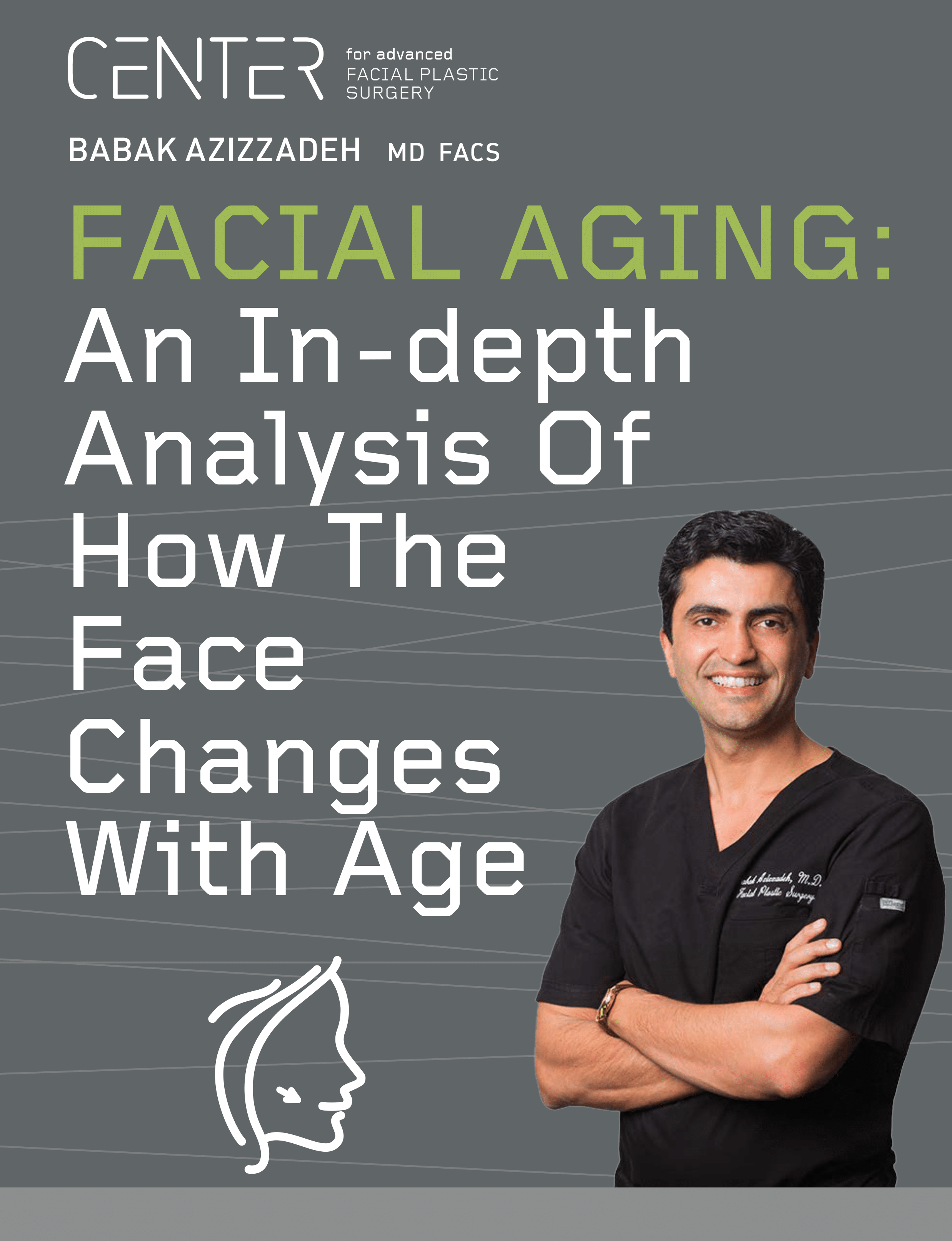Click PDF image below to download
Introduction
Facial skin is impacted by intrinsic and extrinsic factors. Collagen and elastin fibers in the facial skin gradually degrade, and the quality of hyaluronic acid in the body deteriorates as well. The end result: facial aging.
Facial aging involves visible changes in the cheeks, chin and other facial areas. Although there is no-one-size-fits all solution to prevent the facial aging process, treatments are available to help people reduce or eliminate facial aging symptoms.
At the CENTER for Advanced Facial Plastic Surgery in Los Angeles, we want to educate our patients about all aspects of facial aging. Now, let’s take a look at facial aging, its side effects and how it can be treated.
What Is Facial Aging?
Facial aging affects both men and women. As a person gets older, his or her facial skin loses elasticity and tone, resulting in fine and coarse wrinkles. Additionally, a person’s facial skin sometimes becomes rough and dry, and the outer layer of his or her skin may become thinner.
Facial aging occurs at the cellular level. Research indicates the production of fibroblasts, cells that produce collagen and other fibers that promote healthy facial skin, decreases over time. Langerhans cells of the skin also undergo morphologic and functional changes as a person ages. This results in reduced production of Langerhans cells, as well as increased risk of photoaged skin.
The facial aging process is ongoing. The first signs of facial aging may appear in a person’s 20s. Without proper facial skin care and protection, an individual’s facial aging symptoms may escalate quickly.
Individuals who understand the causes of facial aging are well-equipped to minimize its impact. These individuals can take the necessary steps to alleviate facial aging symptoms and maintain a healthy, youthful-looking facial appearance for years to come.
What Causes Facial Aging?
Facial aging is complex, and there are many factors that impact the facial aging process. These factors include:

1. Genetics
Research indicates up to 60% of skin aging takes place due to genetics. Also, studies have shown that individuals with longer telomere sequences in their DNA tend to maintain healthier-looking skin longer than people with shorter telomere sequences.
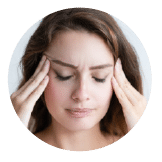
2. Stress
Stress puts additional pressure on the body and hinders a person’s sebum production, microcirculation and hydration levels, all of which put a person’s facial skin in danger. Stress may cause free radical damage that further accelerates the facial aging process, too.
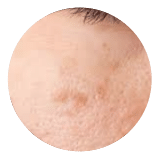
3. Sun Exposure
Excess sun exposure may cause pre-cancerous and cancerous facial skin lesions. It may also result in freckles and irregular facial skin pigmentation.
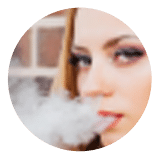
4. Smoking
Smoking deprives facial tissue of oxygen, leading to sallow, lined skin. It also damages capillaries that carry away free radicals.
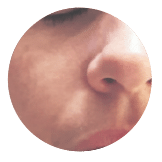
5. Loss of Facial Fat
Facial deflation and volume changes are common in facial soft tissue and fat compartments during the natural aging process. They increase skin laxity, along with cause folds around the face’s nasolabial and periorbital regions and jowl.
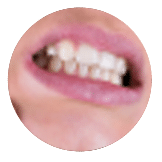
6. Repeated Facial Expressions
Muscle contractions associated with smiling, frowning and other repeated facial expressions may cause facial skin changes. In some cases, repeated facial expressions may accelerate the facial aging cycle.
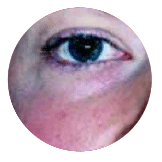
7. Reduced Bone Volume
Research shows the facial bones serve as “scaffolding” for facial skin and tissue. Yet facial bones recede as a person gets older. When this occurs, the bones around an individual’s eye sockets may widen, and his or her brow bone may shrink. In this scenario, a person’s jawbone may also appear less defined than ever before.
The facial aging process varies based on the individual. If a person can identify the early warning signs of facial aging, however, he or she can address these issues before they get out of hand.
What Are the Warning Signs of Facial Aging?
The initial warning signs of facial aging may appear without notice, and facial aging may result in one or more of the following symptoms:
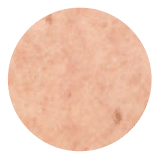
1. Dry Skin
A person may be prone to dry facial skin based on his or her location, the amount of time that he or she spends outdoors and other factors. Dry skin occurs when a person’s skin loses moisture; this makes the skin tight and rough. If dry skin goes untreated, the skin may also become itchy, scaly and chapped.
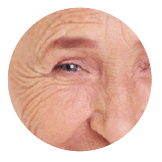
2. Fine Lines and Wrinkles
Fine lines and wrinkles occur naturally. As the facial skin becomes thinner, drier and less elastic over time, a person’s risk of fine lines and wrinkles increases accordingly. Meanwhile, repeated facial expressions may increase a person’s risk of experiencing fine lines and wrinkles at a young age.
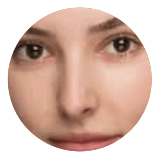
3. Dull Skin
Dead skin cells accumulate on a person’s facial skin, making a person susceptible to dull facial skin. Although skin renewal occurs every 10 years, research shows the skin renewal process slows down as a person ages. Thus, as a person gets older, it becomes increasingly difficult for him or her to produce new skin cells and minimize the risk of dull skin.
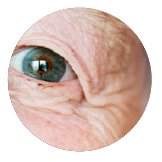
4. Sagging Skin
As underlying tissue in the skin wears down, the cheeks and jawline sag, resulting in wrinkles. Also, loss of fatty tissue or muscle mass in the face may result in lax skin in the cheeks and jawline.
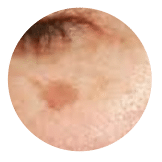
5. Sunspots
Sunspots, also referred to as liver spots, are common in individuals older than 40. They develop due to excess sun exposure; in this instance, the sun’s ultraviolet (UV) rays cause pigmented skin cells to multiply, resulting in flat, brown spots on the face. The size and shape of sunspots varies, and they are usually not cancerous.
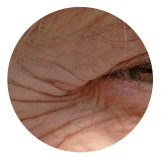
6. Crow’s Feet
Crow’s feet refer to wrinkles that form at the outer corner of a person’s eyes, and they sometimes start to appear in a person’s mid-to-late 20s. Since the skin around the eyes is extremely thin, it tends to lose collagen and elasticity faster than skin in other portions of the face. In this case, crow’s feet may form around the eyes.
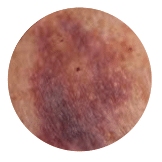
7. Weak Skin
Blood vessels in the face become weaker and thinner due to the natural aging process. This increases the risk that a person’s blood vessel walls will break. In this scenario, an individual may be susceptible to facial skin bruising.
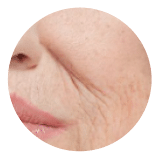
8. Loss of Skin Firmness
Facial skin loses collagen over time. This leads to reduced facial skin firmness, as well as loose, sagging facial skin.
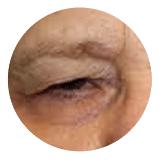
9. Drooping Eyelids
Loss of collagen and elasticity in the face sometimes causes skin to sag near the upper eyelids. Drooping eyelids may result in wrinkles. Plus, they may impair a person’s vision.
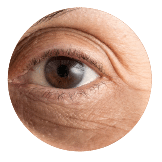
10. Dark Eye Circles
Dark eye circles often occur due to a combination of stress, dehydration and exhaustion. They are sometimes linked to loss of fat, collagen and bone deterioration in the eye socket that takes place as a person ages.
Facial aging impacts different parts of the face as well. If a person understands the immediate and long-term effects of facial aging, he or she can determine the best way to treat various facial aging symptoms.
How Does Aging Affect The Different Areas of the Face?
How the natural aging process affects a person’s face varies depending on the individual. Ultimately, aging may impact one or more of the following areas of a person’s face:
1. Cheeks
A person’s cheeks may begin to droop as he or she grows older. When this happens, smile lines and jowls may form.
2. Eyelids
The facial aging process often affects the eyes before other parts of the face. It may cause upper eyelid fat and associated skin laxity, as well as eyelid skin wrinkles. Sometimes, facial aging causes the upper eyelid skin to fall, leading to folds. Fat pockets and puffiness around the eyelids may also occur due to facial aging.
3. Eyebrows and Forehead
Deep wrinkles sometimes form between the eyebrows and in the forehead due to the natural aging process. Also, as a person’s hairline diminishes, his or her forehead may expand.
4. Lips
Collagen production declines as a person ages, and as a result, an individual’s lips may start to appear thin and flat over time. Lip lines are also common signs of facial aging; these vertical wrinkles form around the mouth and may make a person appear older than his or her actual age.
5. Facial Volume
Generally, facial fat is evenly distributed throughout a person’s face when he or she is young. Facial aging causes facial volume loss that results in loose, sagging skin. At the same time, facial aging sometimes leads to excess fat in the face.
Facial aging – regardless of how it affects the face – is treatable. If a person evaluates a wide range of facial aging treatments, this individual can find a safe, effective way to address his or her facial aging symptoms.
Non-Surgical Facial Aging Treatments
There is no shortage of non-surgical facial aging treatments available. Some of the most common facial aging treatments include:
1. Skin Care Products
Moisturizers commonly help people alleviate dry skin. They can also help make the skin less greasy, as well as temporarily treat facial wrinkles.
Prescription facial aging creams are available that often contain retinoids, compounds that promote collagen production. Avita, Avage and Renova are among the most popular prescription creams available to treat facial aging. These creams have been shown to reduce the appearance of wrinkles, sunspots and other visible signs of aging in the face.
2. Dermal Fillers
Dermal fillers, also called facial fillers, treat facial lines caused by lost fat or collagen. They simultaneously reduce common signs of aging in the face and revitalize the facial appearance. Dermal fillers also do not require surgery, and some of the most common dermal fillers used today include:
- Juvederm XC: Corrects moderate to severe facial lines and wrinkles.
- Juvederm Ultra Plus: Plumps the lips.
- Radiesse: Reduces or eliminates skin folds and wrinkles.
- Restylane: Boosts facial volume and fullness, treats moderate to severe facial folds and wrinkles and improves lip fullness.
- Belotero: Treats moderate to severe nasolabial folds.
- Sculptra: Drives collagen growth and minimizes the appearance of facial folds and wrinkles.
- Voluma: Addresses moderate to severe facial folds and wrinkles.
- Volbella: Improves lip volume and limits the appearance of vertical lip lines.
Facial fillers are injected into a person’s face. They smooth out wrinkles and other facial aging symptoms and help a person achieve a youthful-looking facial appearance.
3. Botox
Research indicates Botox ranks as one of the most-popular non-surgical cosmetic procedures. Botox helps smooth fine lines, furrows and wrinkles caused by excess muscle movements in the face.
Botox is delivered via a series of subcutaneous injections into the face. A typical Botox procedure requires only a few minutes to complete, and the treatment results may last up to four months. Plus, a Botox patient can resume his or her normal activities immediately following treatment.
4. Laser Skin Resurfacing
Laser skin resurfacing is often available to individuals dealing with virtually any dermatologic condition. The procedure corrects sun-damaged skin, blemishes, wrinkles and other facial aging symptoms. In doing so, laser skin resurfacing helps a person improve his or her skin texture, tone and pigmentation.
5. Ultherapy
Ultherapy involves the use of ultrasound technology to lift and tighten facial skin. It stimulates collagen growth, as well as tightens loose skin.
Ultherapy can be performed on all planes of the face, and it requires no incisions, scars or downtime. Individuals can use ultherapy to eliminate forehead wrinkles and creases, correct a sagging jawline and reduce the appearance of a double chin. Ultherapy can also help a person tighten a loose neckline and address crow’s feet and smoker’s lines.
Surgery to Address Facial Aging
In addition to non-surgical treatments, surgical procedures are also available to treat facial aging symptoms. Facial aging surgeries include:
1. Facelift
Facelift surgery treats fold lines between the nose and mouth and the loss of youthful contours in the face. That way, a facelift tightens the facial muscles, repairs loose facial skin and improves an individual’s facial contours.
2. Mid Facelift
A mid facelift revitalizes the face below the lower eyelids and cheeks. It treats sagging skin in the middle of the face, deep creases under the lower eyelids and along the nose and loose skin and excess fat under the chin and jaw.
3. Face Reshaping
Face reshaping restores facial volume. It is used to create soft transitions between different facial features. Each face reshaping procedure is also tailored to a patient, ensuring he or she can use the surgery to achieve a balanced, natural-looking facial appearance.
4. Brow Lift
A brow lift eliminates sagging forehead skin. It involves repositioning underlying forehead muscles and tissue, resulting in a smooth, youthful-looking upper face.
5. Neck Lift
Neck lift surgery, sometimes referred to as a lower rhytidectomy, treats facial aging symptoms in the neck and jawline. It addresses loose neck skin and muscle banding in the neck. A neck lift may also be used to correct excess fat under the chin or in the lower portion of the face.
6. Eyelid Lift
Two types of eyelid lifts are available: upper and lower. An upper eyelid lift removes excess skin from the upper eyelids. Comparatively, a lower eyelid lift treats bags that form under the eyes.
7. Buccal Fat Pad Removal
Buccal fat pad removal is used to reduce the appearance of chubby cheeks that occur due to genetics or weight gain. The procedure involves the removal of excess fat pads from the cheeks, resulting in a sculpted, symmetrical facial appearance.
8. Chin Augmentation
Chin augmentation requires the placement of a small implant in front of the cheekbone. The surgery allows a person to correct a weak chin by increasing the length his or her jawline.
For those who are considering non-surgical and surgical treatments to address facial aging symptoms, it is important to consult with an expert facial plastic and reconstructive surgeon like Dr. Babak Azizzadeh. During a consultation, Dr. Azizzadeh learns about a patient and evaluates his or her facial aging symptoms. Next, Dr. Azizzadeh crafts a custom treatment plan for a patient that may include one or more non-surgical or surgical treatments. Dr. Azizzadeh then shares his facial aging treatment plan with his patient and responds to any concerns or questions. Finally, Dr. Azizzadeh and his patient put a facial aging treatment plan into action, and Dr. Azizzadeh monitors a patient’s progress to help this individual optimize his or her results.
Conclusion
Facial aging is unavoidable. Thankfully, treatments are available to help people address facial aging symptoms. With the right approach to facial aging, an individual can prevent his or her facial aging symptoms from becoming long-term problems.
Dr. Azizzadeh is Harvard-trained and possesses dual certification in facial plastic and reconstructive surgery and head and neck surgery. He understands facial aging and the problems associated with it, and he uses his unique expertise to develop a personalized facial aging treatment plan for each of his patients. This approach ensures each of Dr. Azizzadeh’s patients can choose a facial aging treatment that delivers long-lasting results.
Dr. Azizzadeh is happy to meet with a patient and provide him or her with a personalized facial aging treatment recommendation. To schedule a facial aging treatment consultation with Dr. Azizzadeh, please contact us today at 310-657-2203.
